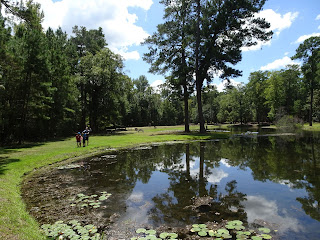 |
| Kings Creek Falls |
But
the region remains wild. Isolated, winding mountain roads require 1 ½ hours
driving time to reach the campground from Greenville, including the last 3 on
gravel Burrells Ford Road. At one point those wishing to camp at the Burrells
Ford campground could drive right to their campsite, but all that changed when
the Chattooga River received the “Wild & Scenic” designation in 1974. Now
parking is in a lot just off the gravel road, and requires a ½ mile hike down
the old road bed to reach the campground.
The
confluence of trails can provide some confusion, and the mileages can be hard
to pin down. There are two parking areas: one for the campground, and a second
closer to the Chattooga on the edge of Ellicott Rock Wilderness. The Chattooga
Trail (blazed green) stays along the river through the campground and emerges
at this second parking area, while the Foothills Trail (blazed white) curves
away from the river south of the campground and emerges adjacent to the
campground parking area. There are several connector trails from the Foothills
Trail to the Chattooga Trail, as well as additional spur trails to the
waterfalls. Add in to that East Fork Trail leading to the only other road in
this corner of the state (Fish Hatchery Road), and the horrible map posted at
the trailheads, and you have an idea of why you need to come prepared with a
good map if you’re planning on doing any hiking. We used National Geographic’s
Sumter National Forest map on our Chattooga Trail hike, but later I utilized a
Forest Service map to make a more detailed version of the campground area, as
seen here.
 |
| Map of Burrells Ford campground area, as adapted from USFS map |
But
pack enough for a weekend, and plan to explore. Park at the first parking area
(for the campground), and follow the road down to the tent sites. You’ve got
bear-proof trash receptacles near the restrooms (in reality pit toilets, but luxurious
compared to the alternative), and picnic tables, lantern posts, fire rings
& bear poles in each campground. Some of the sites are right along the
Chattooga, while others are scattered through the woods. Remember to pack
appropriately, as your return trip will be all uphill. The walk in possibly
deters a portion of the car campers, and the campsites cannot be reserved ahead
of time; plan accordingly.
From
the campground take a hike to Ellicott Rock Wilderness following the Chattooga
Trail; Ellicott Rock is about 4 miles north (one way), but scenic Spoonauger
Falls is less than a mile. Or, head south on the Chattooga/Foothills Trail,
destination Oconee State Park (16.4 miles), Ridley Fields (11.8 miles), the Bartram Trail junction (8.1 miles) or Cherry
Hill campground (about 10 miles?). Of course you could just go ahead and hike the rest of the Foothills Trail - 59.8 miles to Table Rock State Park!
Another option is to stay in the campground; Burrells Ford is the gateway to
some of the most premium trout water in the Southeast. The SC DNR stocks the
river with rainbow, brown and native brook trout grown nearby at the Fish
Hatchery. The river is easily accessed from Chattooga Trail and most of the
campsites, and even in October the boys were happy to get their feet wet.
The
high point of a stop at Burrells Ford is the proximity to two of the most
picturesque waterfalls in South Carolina, King Creek Falls and Spoonauger
Falls. King Creek Falls is just west of the campground, and is a 70 foot,
tiered waterfall that is less than a mile, roundtrip (about 1.4 there and back
if you're starting at the campground parking area).
If you
are interested in reading more about the history of the area, the Rabun Chapter
of Trout Unlimited posted this informative article about the Chattooga
Coalition.
The US
Forest Service Burrells Ford webpage is here.
More
on the Ellicott Rock Wilderness area…
…and
my post on the Chattooga Trail is here.












































